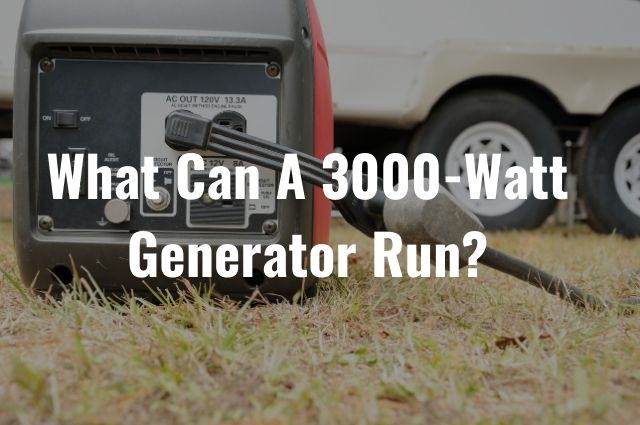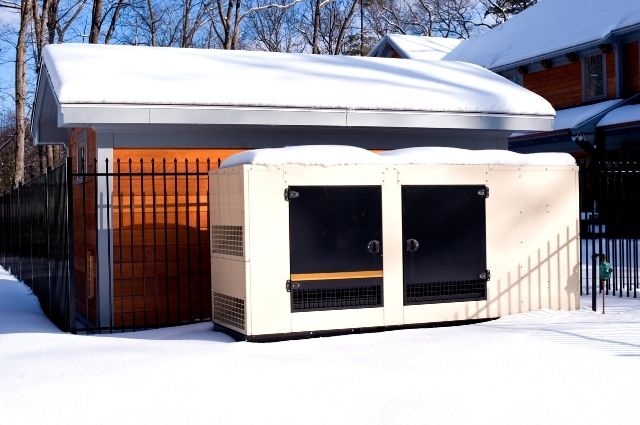Generators play a crucial role in providing backup power during outages, natural disasters, and outdoor events. With various sizes and capacities available, it’s essential to choose the right generator for your specific needs.
A 3000-watt generator can run several household essentials like refrigerators, sump pumps, lights, fans, computers, and small power tools. However, it may not be able to handle high-wattage items like air conditioners or large power-hungry appliances. Always check the specific power requirements of your devices to ensure they fall within the generator’s capacity.
In this blog post, we’ll focus on the 3000-watt generator, explaining its capabilities and limitations, and discussing what appliances and devices it can run.
Understanding Wattage and Power Requirements
Watts are a unit of power, representing the rate at which energy is consumed or produced. When it comes to generators, wattage indicates the amount of power it can provide to your appliances and devices. To determine if a 3000-watt generator is suitable for your needs, you need to calculate the wattage requirements of your appliances.
Keep in mind that some appliances require more power to start than to run continuously. These starting watts are typically higher than the running watts, so it’s crucial to consider both when calculating your power requirements.
Peak watt Vs. Running Watt
When you talk about the generator, you have to consider the generator’s peak watt and running watt.
The Peak watt is higher than the running watt of a generator. You will get the pick watt for about 5 seconds when you start the generator. Then the generator will run in the running watt.
For example, in a 3000-watt portable generator, you will get 3000 peak watts and 2300 to 2500 running watts.

Inverter vs. Open frame 3000-Watt Generator
The concept of an inverter generator is comparatively newer. An inverter generator is more expensive than a conventional open-frame generator.
An inverter generator is perfect for sensitive appliances like a laptop, smartphone, television, etc.
Moreover, the inverter generator needs less fuel than the open-frame generator. Additionally, you can connect two inverter generators parallel to increase the power output.
If you don’t need to run the sensitive generator, then the open-frame 3000-watt generator is enough for you. But the inverter generator is recommended for camping, RV, and home use for its low-noise features and appliances that need low wattage to run.
Common Appliances and Devices a 3000-Watt Generator Can Power
A. Household appliances
- Refrigerators and freezers: A 3000-watt generator can typically power a medium-sized refrigerator or freezer, consuming around 1200-1500 starting watts.
- Microwaves and toaster ovens: Most microwaves and toaster ovens consume between 600 and 1200 watts, making them compatible with a 3000-watt generator.
- Small air conditioners and fans: Portable air conditioners and fans can be powered by a 3000-watt generator, as long as their wattage requirements do not exceed the generator’s capacity.
B. Electronics
- Televisions and computers: LED or LCD TVs and desktop computers usually require between 100 and 400 watts, making them suitable for a 3000-watt generator.
- Mobile devices and chargers: Charging smartphones, tablets, and laptops requires minimal power, typically well within the capacity of a 3000-watt generator.
- Home office equipment: Printers, routers, and other home office devices typically have low power requirements and can be powered by a 3000-watt generator.
C. Power tools and outdoor equipment
- Lawnmowers and trimmers: Electric lawnmowers and trimmers have varying power requirements but can often be powered by a 3000-watt generator.
- Drills and saws: Most handheld power tools, like drills and saws, have power requirements within the range of a 3000-watt generator.
- Pressure washers: Smaller electric pressure washers can be powered by a 3000-watt generator, but larger models may require more power.
D. Lighting and miscellaneous devices
- LED and CFL bulbs: Energy-efficient lighting options like LED and CFL bulbs have low power requirements, making them ideal for use with a 3000-watt generator.
- Heaters and dehumidifiers: Small space heaters and dehumidifiers can typically be powered by a 3000-watt generator.
- Sump pumps: Many sump pumps have power requirements within the capacity of a 3000-watt generator, but it’s essential to check the specific wattage requirements before relying on the generator for backup power.
Real-life example
For Home Use
During a prolonged power outage, a 3000-watt portable generator can run the necessary appliances of your home. As a homeowner, you want to run at least the light, refrigerator, and fridge with your generator. A sump pump or well pump is another much-needed appliance during a power outage.
Surprisingly, you could run more than the mentioned appliances. Because if you use a medium-sized freezer and regular refrigerator and light, they will consume no more than 1200-1500 watts. So, you can run other appliances with a portable generator.
You can use your furnace, washing machine, television, and air conditioner with the appliances mentioned above. But you could calculate whether your 3000-watt generator can take the load or not.
| Appliance | Wattage |
|---|---|
| Blender | 300-watt |
| Coffee Maker | 800-watt |
| Dishwasher | 300-watt |
| Electric Can Opener | 170-watt |
| Food Processor | 400-watt |
| Electric Grill | 1600-watt |
| Microwave Oven 600 W | 600-watt |
| Toaster Oven | 850-watt |
| Refrigerator | 700-watt |
| Air conditioning | 1,000 to 4,000 watts |
| Sump or well pump | 1,000 watts |
| Light bulb | 60 watts |
| Television | 200 watts |
These are the estimated size of commonly used home appliances. Please read the manual of your devices to get the right idea. Moreover, these are the running watt. You should consider the starting watt in the case of induction motor-driven appliances like the refrigerator. They need more starting watts than running watts.

RV life
the calculation is almost the same here as the home appliances during the power outage. Moreover, the devices in an RV are lighter than the home. So, you can definitely run more tools here rather than in your home during the power outage.
For example, you can run a conditioner, light, refrigerator, coffee machine, electric cooker, and microvan with your 3000-watt portable generator.
Most importantly, you can run your refrigerator, electric cooker, and air-conditioner at a time with a 3000-watt generator in the RV. That’s cool, indeed.
| ApplianceConvection oven 700-1500 Appliance | Wattage |
|---|---|
| Air conditioner | 1200-2400 watt |
| Blender | 600-watt |
| Coffee maker | 500-1000 |
| Laptop | 50-100 |
| Curling iron | 20-50 |
| Drill | 250 750 |
| Refrigerator | 400 -1000 |
| Convection oven | 700-1500 |
| Battery charger up to | 3000 watt |
| Electric blanket | 250 -700 |
| Radio | 50 200 |
| Water heater | 1000 – 1500 |
| Water pump | 500-600 |
A portable Inverter generator is best for an RV. For your RV, you could choose the 3000-watt portable RV generator. It is fuel-saving and produces less noise than the open-frame generator. You could most importantly run sensitive appliances like the laptop, a smartphones with a 3000-watt inverter generator.
Tailgating
For successful and enjoyable tailgating, a generator is a much-needed item. A 3000-watt portable generator is enough for powering your tailgating.
You could run your mini-fridge or cooler to keep the drinks cold. Your television, laptop, and mini-fridge will not exceed 1000 watts actually.
Moreover, you have the flexibility to run the electric grill instead of the charcoal grill during tailgating with your 3000-watt portable generator. which is a cool option indeed.
| Appliance | Wattage |
|---|---|
| Mini fridge | 50-65 watt |
| Electric grill | 1000-1500 wat |
| Laptop | 50 |
| Mobile charger | 2-6 |
| Television | 400 watt |
Garage Tool
A 3000-watt portable generator is a popular choice for woodworkers and contractors. Even you could use this one for your garage tools. But you should not run your portable generator inside the garage for safety purposes.
A 3000-watt generator is enough for running the small to medium power tools smoothly. Yes, you can not run multiple medium-size power tools at a time with a 3000-watt generator.
For example, a circular saw consumes 1400 watts, and it needs almost 2300 watts. On the other hand, the air compressor needs 1200 watts to run.
You know, you should not use more than 75% power of your generator at a time. It is harmful to the generator, along with the appliances.
| Appliance | Wattage |
|---|---|
| Table saw | 1,400 watts |
| Portable air compressor | 1,500 watts |
| Reciprocating Saw | 900-watt |
| Electric drill | 600 watts |
| Chainsaw | 1,500 watts |
| Corded Hedge Trimmer (4 Amps) | 500-watt |
| Electric leaf blower | 1000-watt |
Please remember these are estimated wattages only. So you should double-check the manual to know the exact power of your tools.
Office Appliances
| Appliance | Watt |
|---|---|
| Personal Computer w/17″ Monitor | 800-watt |
| Laser Printer | 950 |
| Inkjet Printer | 80 |
| Copy Machine | 1600 |
| Fax Machine | 65 |
Limitations of a 3000-Watt Generator
A. Appliances and devices that may exceed the generator’s capacity
- Central air conditioning units: Most central air conditioning systems require more than 3000 watts, making them unsuitable for use with a 3000-watt generator.
- Large electric stoves and ovens: High-capacity electric stoves and ovens often require more power than a 3000-watt generator can provide, especially when using multiple burners or heating elements simultaneously.
- High-capacity water heaters: Large water heaters, particularly those used for whole-house systems, may exceed the capacity of a 3000-watt generator.
B. Factors affecting power output
- Altitude: Generators usually lose power output at higher altitudes, which can affect their ability to run certain appliances or devices.
- Temperature: Extreme temperatures can impact a generator’s performance and its ability to deliver the full 3000 watts of power.
- Fuel type and quality: Using low-quality fuel or the incorrect fuel type for your generator can lead to reduced performance and output.
C. Importance of not overloading the generator
Overloading a generator can cause damage to both the generator and the appliances connected to it. To avoid overloading, always calculate the total wattage required by the appliances and devices you plan to use and ensure it does not exceed the generator’s capacity. Remember to consider both starting and running watts when making these calculations.
Tips for Maximizing the Efficiency of a 3000-Watt Generator
Prioritizing essential appliances and devices
To make the most of your 3000-watt generator, prioritize powering essential appliances and devices, such as refrigerators, lighting, and communication devices.
Staggering usage to avoid simultaneous power draw
By avoiding the use of multiple high-wattage appliances or devices simultaneously, you can stay within the generator’s capacity and avoid overloading.
Using energy-efficient appliances and devices
Opt for energy-efficient models to minimize power consumption, allowing you to run more appliances and devices within the 3000-watt limit.
Regular maintenance to ensure optimal performance
Perform regular maintenance on your generator, including oil changes, spark plug replacements, and air filter cleanings, to keep it running at peak performance and delivering the full 3000 watts of power.
FAQ on the 3000-watt generator
can a 3000-watt generator run a refrigerator?
Yes, a 3000-watt generator can typically run a medium-sized refrigerator. Most refrigerators consume around 1200-1500 starting watts and 150-200 running watts. However, it is essential to check the specific wattage requirements of your refrigerator to ensure that it falls within the capacity of the 3000-watt generator.
will a 3000-watt generator run a house?
A 3000-watt generator can provide backup power for a house, but it will not be able to power everything simultaneously. Its capacity is limited, and you will need to prioritize essential appliances and devices.
With a 3000-watt generator, you can typically run some basic appliances and devices such as a refrigerator, a few lights, and a television, and charge your mobile devices. However, it won’t be able to power large appliances like a central air conditioning unit, an electric stove, or a whole-house water heater.
will a 3000-watt generator run an air conditioner?
A 3000-watt generator can run a small air conditioner, such as a window or portable unit, but it may not have enough capacity to power a large central air conditioning system.
Small air conditioners typically require between 500 and 1500 watts, depending on their size and cooling capacity, which would be suitable for a 3000-watt generator. However, central air conditioning systems often require more than 3000 watts, making them unsuitable for use with a generator of this size.
how long will a 3000-watt generator run?
The runtime of a 3000-watt generator depends on several factors, including its fuel capacity, fuel type, fuel efficiency, and the load being powered.
Most 3000-watt generators have a fuel tank that can hold between 3 to 6 gallons (11 to 23 liters) of gasoline. Under a 50% load, a generator with a fuel-efficient engine can typically run for 8 to 12 hours on a full tank. However, the runtime may be shorter if the generator is running at full capacity or if it has a less efficient engine.
Keep in mind that the generator’s runtime can also be affected by factors such as altitude, temperature, and fuel quality. Always refer to the manufacturer’s specifications and guidelines for accurate information on the runtime of a specific 3000-watt generator model.
what can a 3000-watt inverter generator run?
- Medium-sized refrigerator or freezer
- Microwave or toaster oven
- Small air conditioner or fan
- LED or LCD TV
- Desktop computer
- Smartphone, tablet, and laptop chargers
- Home office equipment (printers, routers)
- Electric lawnmower or trimmer
- Handheld power tools (drills, saws)
- Small electric pressure washer
- LED and CFL light bulbs
- Small space heater
- Dehumidifier
- Sump pump
what can a 2300-watt generator run?
A 2300-watt generator can run a variety of smaller appliances and devices. Here’s a list of items that can typically be powered by a 2300-watt generator:
- Small to medium-sized refrigerator or freezer
- Microwave oven
- Coffee maker
- Blender
- LED or LCD TV
- Desktop computer or laptop
- Smartphone and tablet chargers
- Home office equipment (printers, routers)
- Handheld power tools (drills, saws)
- Fans of small portable heaters
- LED and CFL light bulbs
- Electric trimmer or hedge clipper
Summary
A 3000-watt generator offers a versatile solution for powering a variety of appliances and devices in different situations, from power outages to outdoor events. By understanding its capabilities and limitations, you can make informed decisions about which appliances and devices to run with your generator.
With careful planning and responsible usage, a 3000-watt generator can be a valuable asset in providing backup power and ensuring the smooth operation of your home or event.
Related Post:
Recent Posts
Yes, synthetic oil can generally be used in generators. It offers superior lubrication, improved resistance to temperature variations, and longevity compared to conventional oil, which can enhance...
In today's digital age, our dependency on computers and other electronic devices is undeniable. But what happens when a power outage occurs? This is where generators come in. However, is it safe to...
